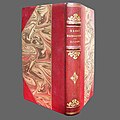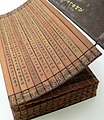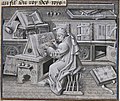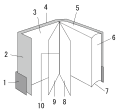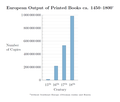Portal:Books
The Books Portal
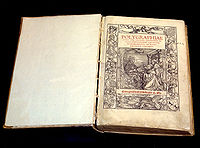
A book is a medium for recording information in the form of writing or images. Books are typically composed of many pages, bound together and protected by a cover. Modern bound books were preceded by many other written mediums, such as the codex and the scroll. The book publishing process is the series of steps involved in their creation and dissemination.
As a conceptual object, a book typically refers to a written work of substantial length, which may be distributed either physically or in digital forms like ebooks. These works are broadly classified into fiction (containing imaginary content) and non-fiction (containing content representing truths). Many smaller categories exist within these, such as children's literature meant to match the reading level and interests of children, or reference works that gather collections of non-fiction. Books are traded at both regular stores and specialized bookstores, and people can borrow them from libraries. The reception of books has led to a number of social consequences, including censorship.
A physical book does not need to contain written works: for example, it may contain only drawings, engravings, photographs, puzzles, or removable content like paper dolls. Physical books may be left empty to be used for writing or drawing, such as account books, appointment books, autograph books, notebooks, diaries and sketchbooks.
The contemporary book industry has seen several major changes due to new technologies. In some markets, the sale of printed books has decreased due to the increased use of eBooks. However, printed books still largely outsell eBooks, and many people have a preference for print. The 21st century has also seen a rapid rise in the popularity of audiobooks, which are recordings of books being read aloud. Additionally, awareness of the needs of people who can't access print media due to limitations like visual impairment has led to a rise in formats designed for greater accessibility, such as braille printing or formats supporting text-to-voice. Google Books estimated that as of 2010, approximately 130,000,000 unique books had been published. (Full article...)
Selected article
The wordless novel is a narrative genre that uses sequences of captionless pictures to tell a story. As artists have often made such books using woodcut and other relief printing techniques, the terms woodcut novel or novel in woodcuts are also used. The genre flourished primarily in the 1920s and 1930s and was most popular in Germany.
The wordless novel has its origin in the German Expressionist movement of the early 20th century. The typically socialist work drew inspiration from medieval woodcuts and used the awkward look of that medium to express angst and frustration at social injustice. The first such book was the Belgian Frans Masereel's 25 Images of a Man's Passion, published in 1918. The German Otto Nückel and other artists followed Masereel's example. Lynd Ward brought the genre to the United States in 1929 when he produced Gods' Man, which inspired other American wordless novels and a parody in 1930 by cartoonist Milt Gross with He Done Her Wrong. Following an early-1930s peak in production and popularity, the genre waned in the face of competition from sound films and anti-socialist censorship in Nazi Germany and the US.
Following World War II, new examples of wordless novels became increasingly rare, and early works went out of print. Interest began to revive in the 1960s when the American comics fandom subculture came to see wordless novels as prototypical book-length comics. In the 1970s, the example of the wordless novel inspired cartoonists such as Will Eisner and Art Spiegelman to create book-length non-genre comics—"graphic novels". Cartoonists such as Eric Drooker and Peter Kuper took direct inspiration from wordless novels to create wordless graphic novels.
Selected picture
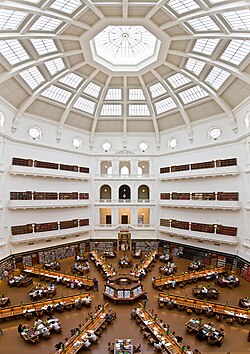
Credit: Diliff
Books topics
Related portals
Web resources
- Bookbinding and the Conservation of books, A Dictionary of Descriptive Terminology, 1982 by Matt T. Roberts and Don Etherington
- IOBA glossary of book terms
- Project Gutenberg - Free e-Books
- Words at Large: The best in books from CBC.ca
- please add more!
Selected biography

Joseph Johnson (15 November 1738 – 20 December 1809) was an influential 18th-century London bookseller and publisher. His publications covered a wide variety of genres and a broad spectrum of opinions on important issues. Johnson is best known for publishing the works of radical thinkers such as Mary Wollstonecraft, William Godwin, Thomas Malthus, Erasmus Darwin and Joel Barlow, feminist economist Priscilla Wakefield, as well as religious Dissenters such as Joseph Priestley, Anna Laetitia Barbauld, Gilbert Wakefield, and George Walker.
In the 1760s, Johnson established his publishing business, which focused primarily on religious works. He also became friends with Priestley and the artist Henry Fuseli – two relationships that lasted his entire life and brought him much business. In the 1770s and 1780s, Johnson expanded his business, publishing important works in medicine and children's literature as well as the popular poetry of William Cowper and Erasmus Darwin. Throughout his career, Johnson helped shape the thought of his era not only through his publications, but also through his support of innovative writers and thinkers. He fostered the open discussion of new ideas, particularly at his famous weekly dinners, the regular attendees of which became known as the "Johnson Circle". (Full article...)
Selected quote

| “ | Knowing I lov'd my books, he furnish'd me From mine own library with volumes that I prize above my dukedom. | ” |
| — William Shakespeare | ||
Did you know...
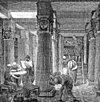
- ...that Library of Alexandria was once the largest library in the world?(Pictured)
- ...that the government of Bavaria, in agreement with the federal government of Germany, does not allow any copying or printing of Mein Kampf in Germany?
- ...that among the books that end up in the Simpson's fireplace in episode Dog of Death are The Lottery by Shirley Jackson, Fahrenheit 451 by Ray Bradbury (which ironically enough, is about a society where books are burned),and Fatherhood by Bill Cosby?
General images
Books lists
WikiProjects
Categories
Things you can do

- Find news articles regarding notable books and add them to the "In the news" section.
- Expand this portal and book-related articles: List of Jamaican books
- Create new articles: Lists of books provides a comprehensive list of notable books, many of which have no articles.
- Add references: List of CEO books, List of anonymously published works
- Make this portal more complete:
- Add {{WPBooks}} to the Talk pages of articles about notable books – but try to add an initial Assessment from the Wikipedia:WikiProject_Books
- Add
{{Portal|Books}}to appropriate articles within the subject
- Anything else you can think of doing.
Associated Wikimedia
The following Wikimedia Foundation sister projects provide more on this subject:
-
Commons
Free media repository -
Wikibooks
Free textbooks and manuals -
Wikidata
Free knowledge base -
Wikinews
Free-content news -
Wikiquote
Collection of quotations -
Wikisource
Free-content library -
Wikispecies
Directory of species -
Wikiversity
Free learning tools -
Wikivoyage
Free travel guide -
Wiktionary
Dictionary and thesaurus

